
10th grade English class assignment in Eau Claire Area School District teaches students about “gender identity,” “personal pronouns,” and the “patriarchy”
Incidents
- Issues
- Indoctrination
- Sex and Gender
A concerned resident provided Parents Defending Education with an English assignment given to tenth grade students English class at Memorial High School. This school is part of the Eau Claire Area School District. The assignment appears to be titled “Gender, Gender Identity, and Sexual Orientation.” The assignment states: “Just as we would expect to see people with red hair or blue eyes or people who are left-handed, it is also normal to expect to see a wide range of diversity with the spectrum of human sexual identity.”
The assignment then asks students to name the “four characteristics of human sexual identity.” The answers to this question are “assigned sex,” “gender expression,” “gender identity,” and “sexual orientation.” The assignment then states that “it’s common for people to confuse sex and gender, but they’re actually different things.” Students then have to fill in the blanks for the following statements:
- Sex is a label – male or female – that a person is assigned at birth (usually by a doctor) based on the appearance of external genitalia that person is born with; it goes on their birth certificate.
- Gender (which is much more complex) is a social and legal status and a set of expectations from society about behaviors, characters, and thoughts.
- Each culture has standards about the way that people should behave based on their gender because gender is a social construct. Instead of being about body parts, gender is more about expectations placed on a person’s behavior based on their assigned sex.
The assignment then delves into the topic of “gender identity.” Students must fill in the blanks for the following statement: “Gender identity refers to a person’s internal, deeply held sense of their gender (such as male, female, or an alternative gender like gender nonbinary, genderqueer, or gender nonconforming), according to Crash Course Sociology.” The assignment then has students fill out the following statements:
- Nobody really perfectly fits the cultural ideal of masculinity or femininity. And lots of people construct their gender differently from these conventional ideas.
- In particular, transgender people are those whose gender identity doesn’t match the sex they were assigned at birth; by contrast, cisgender people’s gender identity matches their assigned sex.
- Still, both trans and cis people can express their identity in a variety of ways, conventional or otherwise.
- And this should make it clear that gender, like sex, is not binary.
- There are many ways of being feminine and many ways in which a person can be masculine.
- Since gender identity is internal, a person’s gender identity is not necessarily visible to others.
The assignment has students fill in the blanks for statements on “personal pronouns” next. The assignment states: “In English, whether we realize it or not, people frequently refer to us using personal pronouns (such as “he,” “she,” or “they”) when speaking about us; personal pronouns are pronouns that refer to a unique and individual person.” The assignment then provides the following statements:
- When a person shares their pronouns, they are naming the pronouns that they want to be referred to by in the singular third person (when referring to that person while talking to someone else).
- Using someone’s correct personal pronouns is a way to respect them and create an inclusive, respectful environment, just as a person’s name can be a way to respect them.
- It can be offensive or harassing to guess at someone’s pronouns and refer to them using those pronouns if that is not how that person wants to be known.
- Or, worse, actively choosing to ignore the pronouns someone has stated that they go by could imply the dehumanizing and oppressive notion that intersex, transgender, nonbinary, and gender nonconforming people do not or should not exist.
The assignment then states: “Ericka Gall, MS.Ed., (she/they) is a resident crisis and trauma therapist, poet, cultural facilitator, and anti-racism educator; they created the following list about the impact of ignoring someone’s pronouns.” The assignment then lists “10 Things You’re Actually Saying When Ignoring Someone’s Pronouns”:
- I know you better than you know yourself.
- Your sense of safety and respect is not important to me.
- I’d rather hurt you than change the way I speak about you.
- Your identity isn’t real and shouldn’t be acknowledged.
- You being your true self is an inconvenience to me.
- I want to teach others around me to disrespect you.
- I hear you talking, but I’m not truly listening.
- I’m OK with offending you if it keeps me comfortable.
- My opinion > your feelings.
- I’m not trustworthy nor an ally.
The assignment then provides the following statements for students to fill out regarding gender issues:
- Gender expression refers to the way a person communicates their gender identity to others through behavior, clothing, hairstyles, voice, or body characteristics.
- Societal expectations of gender expression are reinforced in almost every area of life. Even very young children are clear about the gendered choices that children (especially within the gender binary) are “supposed to” make in relation to toys, colors, clothes, games, and activities.
- These arbitrary expectations often add difficulty to people’s attempts to form their identities in healthy ways and discover their authentic selves.
- LGBTQ+ is shorthand for lesbian, gay, bisexual, transgender, queer, and more.
- The “LGB” in this term refers to sexual orientation (lesbian, gay, bisexual).
- The “T” in this term typically refers to gender identities that do not conform to a person’s assigned gender at birth (transgender, gender non-conforming, etc.).
- The “Q” generally refers to queer, which is often used as an umbrella term for other aspects of a person’s human sexual identity and for the entire LGBTQ+ community.
- Coming out is the process of accepting and being open about one’s human sexual identity, such as being lesbian, gay, bisexual, pansexual, transgender, queer, or questioning. It’s short for “coming out of the closet).
- Sometimes it’s replaced with the phrase “inviting people in” to the truth of who someone has been all along but is now sharing with others.
- Sexual orientation is defined as an enduring pattern of emotional, romantic, and/or sexual attractions.
- A person may be attracted to men, women, both, neither, or to people who are genderqueer, androgynous, or have other gender identities. Individuals may identify as lesbian, gay, heterosexual, bisexual, queer, pansexual, or asexual, among others. Some research indicates that sexual orientation is fluid for some people. Like gender identity, sexual orientation is internally held knowledge.
- Homophobia is the fear, hatred, or repulsion of people who are or are thought to be gay, lesbian, bisexual, pansexual, or queer based primarily on sexual orientation.
- Queer erasure is a heteronormative cultural tendency to remove queer individuals or groups intentionally or unintentionally from record, or to dismiss or downplay their significance.
- Heterosexism is the belief or assumption that everyone is _____ and that _____ is the only “right” and “natural” sexual _____.
- Transphobia is the fear, hatred, disbelief, or mistrust of people who are transgender, thought to be _____, or whose _____ _____ doesn’t conform to traditional gender _____. Transphobia can prevent transgender and gender nonconforming people from living full lives free from _____.
- Intersectionality is the _____ nature of social _____ such as race, class, and gender as they apply to a given individual or group, regarded as creating overlapping and interdependent systems of discrimination or disadvantage.
- Gender stereotypes are _____ for a person to _____ or act a certain way based on their _____ gender or assigned sex.
- Hyperfemininity is the _____ of stereotyped behavior that’s believed to be feminine; hyperfeminine people exaggerate the qualities they believe to be feminine.
- This may include being passive, naïve, soft, flirtatious, graceful, nurturing, and accepting.
- Hypermasculinity is the _____ of stereotyped behavior that’s believed to be masculine; hypermasculine people exaggerate the qualities they believe to be masculine.
- They believe they’re supposed to compete with other men and dominate feminine people by being aggressive, worldly, insensitive, physically imposing, ambitious, and demanding.
- Patriarchy is a form of _____ _____ in which men have more power than and dominate other genders.
- Matriarchal, or female-dominated societies, can do this too, but most societies throughout human history have been patriarchies.
- Patriarchal societies are maintained through a careful _____ of the _____, _____, and _____ that favor men and encourage society to believe that one gender is _____ better than others – also known as sexism.
- Little girls may sometimes be encouraged to be tomboys, BUT young boys are often shamed for liking toys that are considering stereotypically feminine – or even the color pink.
- Societies often define and celebrate certain sets of characteristics as being masculine.
- That’s what sociologist Raewyn Connell calls hegemonic masculinity. Hegemonic means dominance by one social group over others.
- Patriarchal norms about masculinity can also _____ _____ _____. For example, men are 3-4 times more likely to die by suicide than women.
- Sexism and the patriarchy have a real impact that make it harder for all genders to be on even footing in our society.
The English assignment then discusses the “Stonewall Riots.” The assignment states: “Before the Stonewall Riots, police often raided gay bars, where victims almost always submitted passively to arrest in order to avoid a brutal assault by the police.” The assignment follows this by having students fill in more blanks for statements related to the topic:
- In the early morning of July 28th, 1969, police raided the Stonewall Inn, a club which catered to the poorest and most _____ queer people: drag queens, transgender people, hustlers, and homeless youth.
- Police officers entered the club, roughed up patrons, and, finding bootlegged alcohol, arrested 13 people, including employees and people violating the state’s gender-appropriate clothing law (female officers would take suspected cross-dressing patrons into the bathroom to inspect their genitals).
- Fed up with constant police _____ and social _____ against queer people, angry patrons and neighborhood residents hung around outside of the bar rather than disperse, becoming increasingly agitated as the events unfolded and people were aggressively manhandled. At one point, an officer hit a lesbian over the head as he forced her into the police vehicle – she shouted to onlookers to act, inciting the crowd to begin throw pennies, cobble stones, and other objects at the police.
- While the first person to defy the police raid remains unidentified, it was either a drag queen or a butch lesbian, and with that first act of defiance, the victims of the raid refused to tolerate the discrimination they had experienced their entire lives. The protests, sometimes involving thousands of people, continued in the area for five more days, flaring up at one point after the Village Voice published its account of the riots.
- Though the Stonewall uprising didn’t start the LGBTQ+ civil rights movement, it was a _____ force for queer _____ _____ and is regarded by historians and anthropologists as history’s first major protest on behalf of _____ _____ for queer people. In 2016, President Barack Obama designated the site of the riots – Stonewall Inn, Christopher Park, and the surrounding streets and side walks – a national monument in recognition of the area’s contribution to queer human rights.
The English assignment ends with the following statement: “The heaviest lifting in any class session like this is always the emotional weight inherently carried by members of any marginalized community when that community is discussed. If that applies to you in any way, thank you for your strength and resilience in being part of this.”
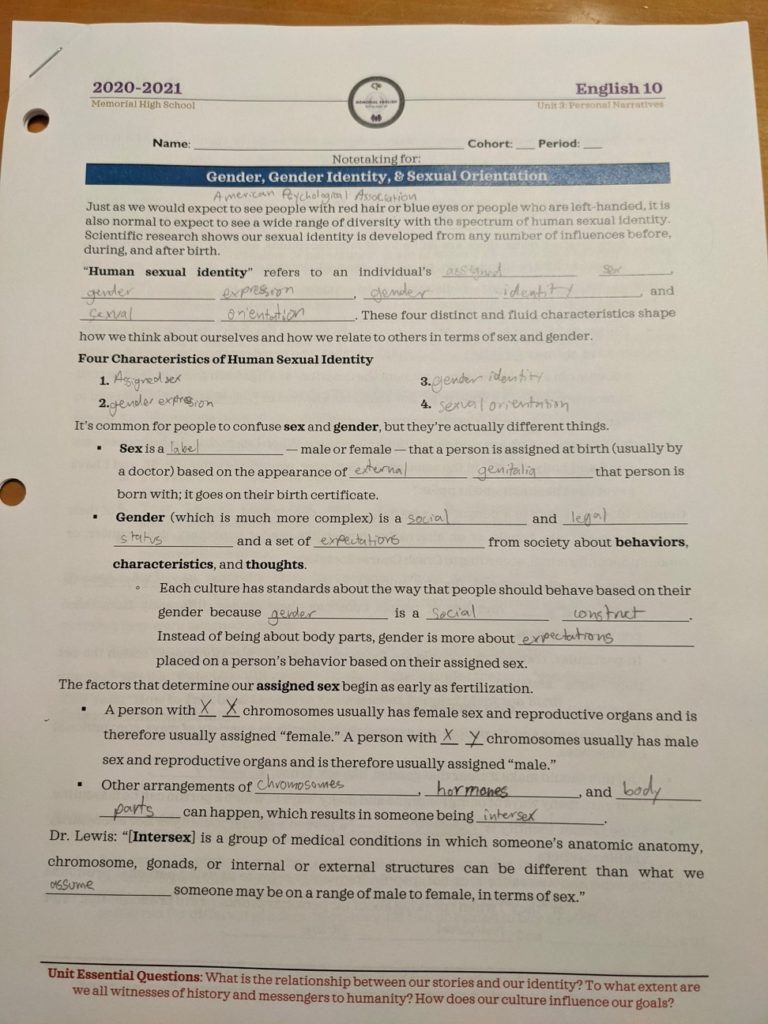
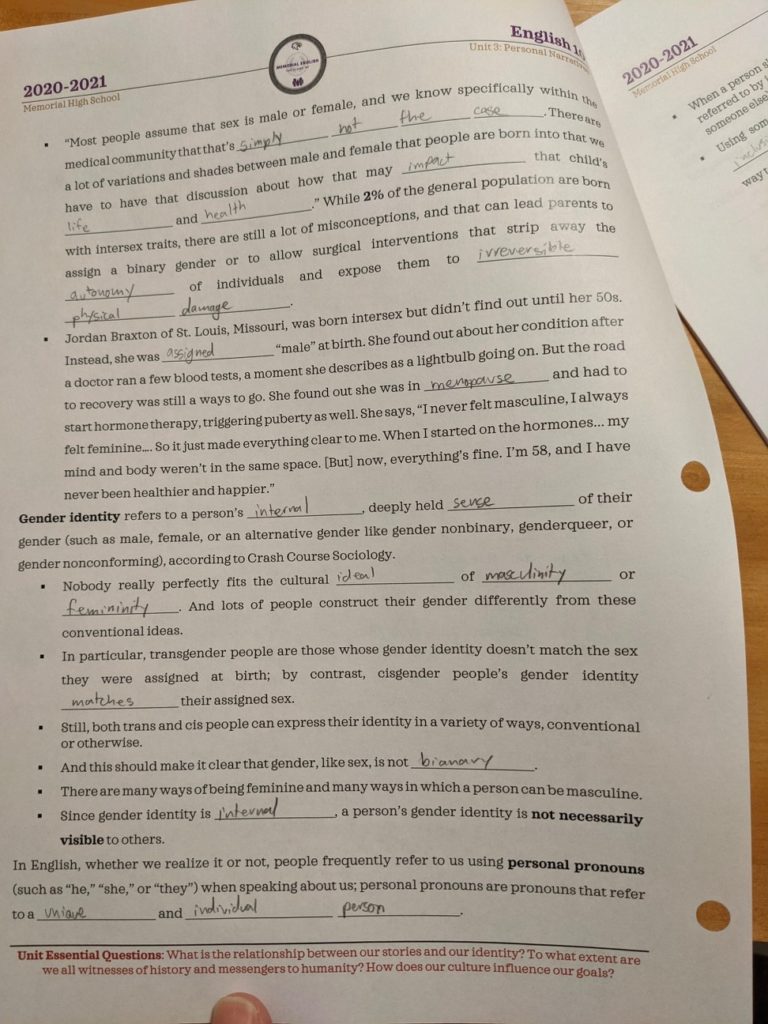

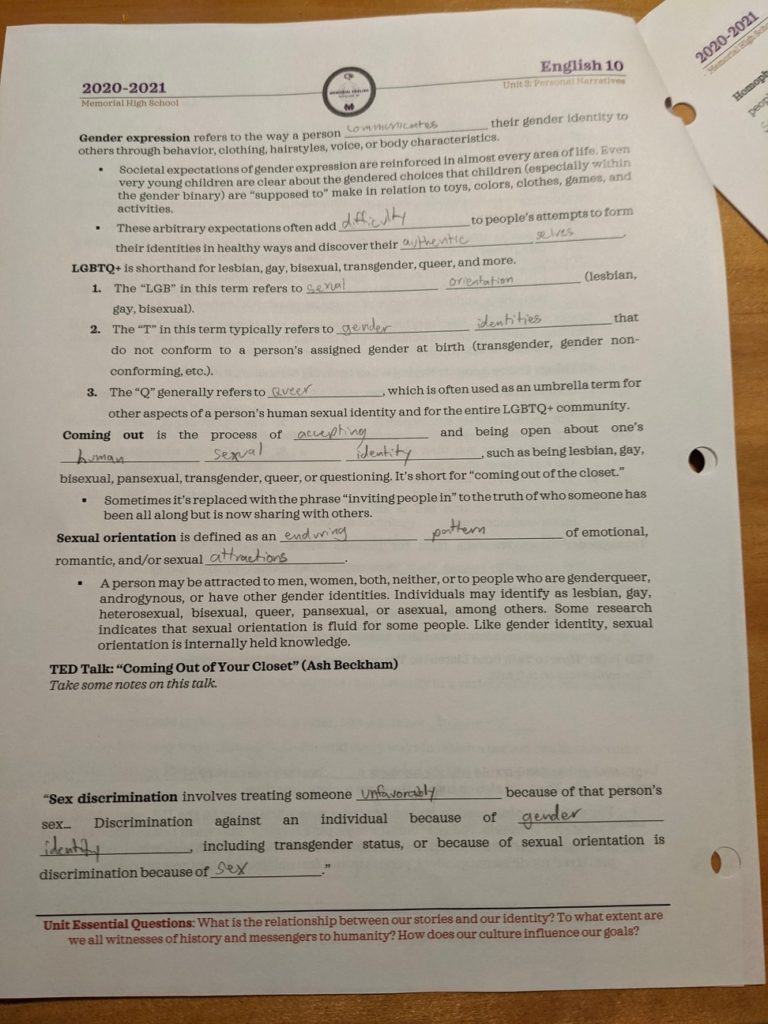

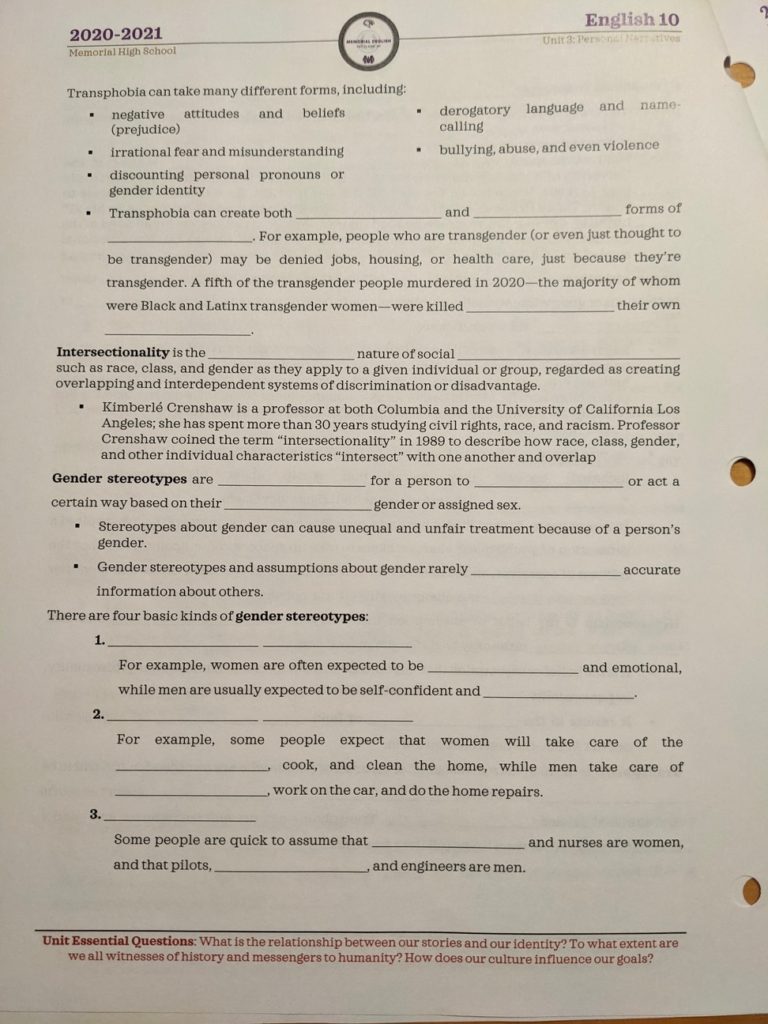
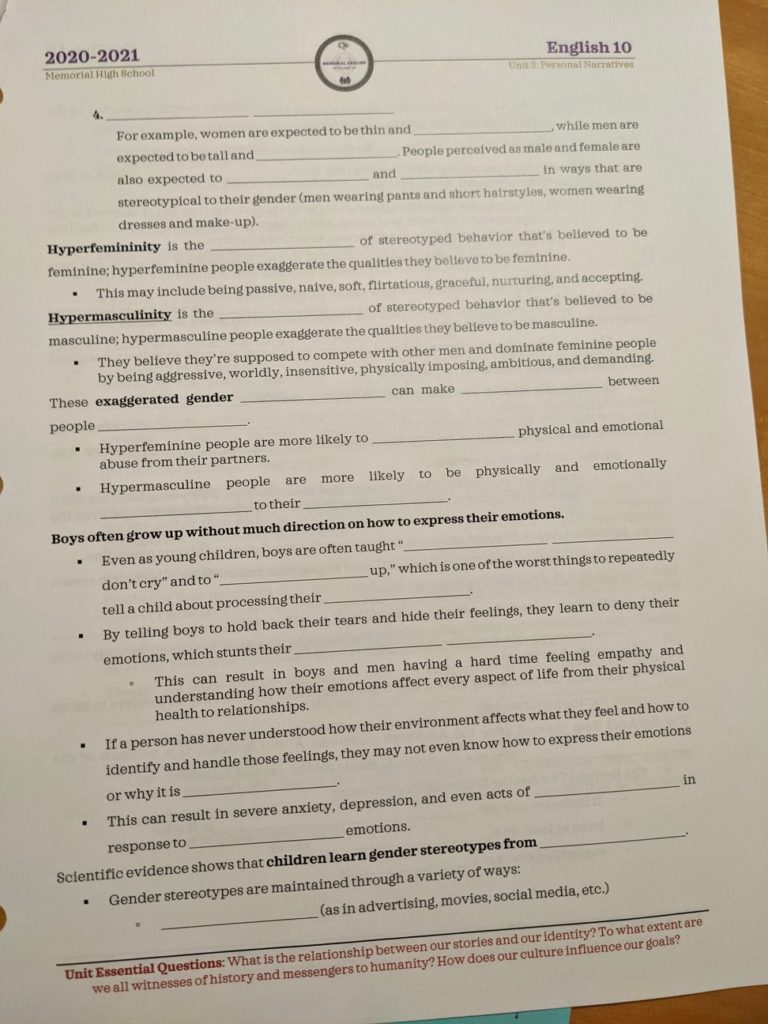

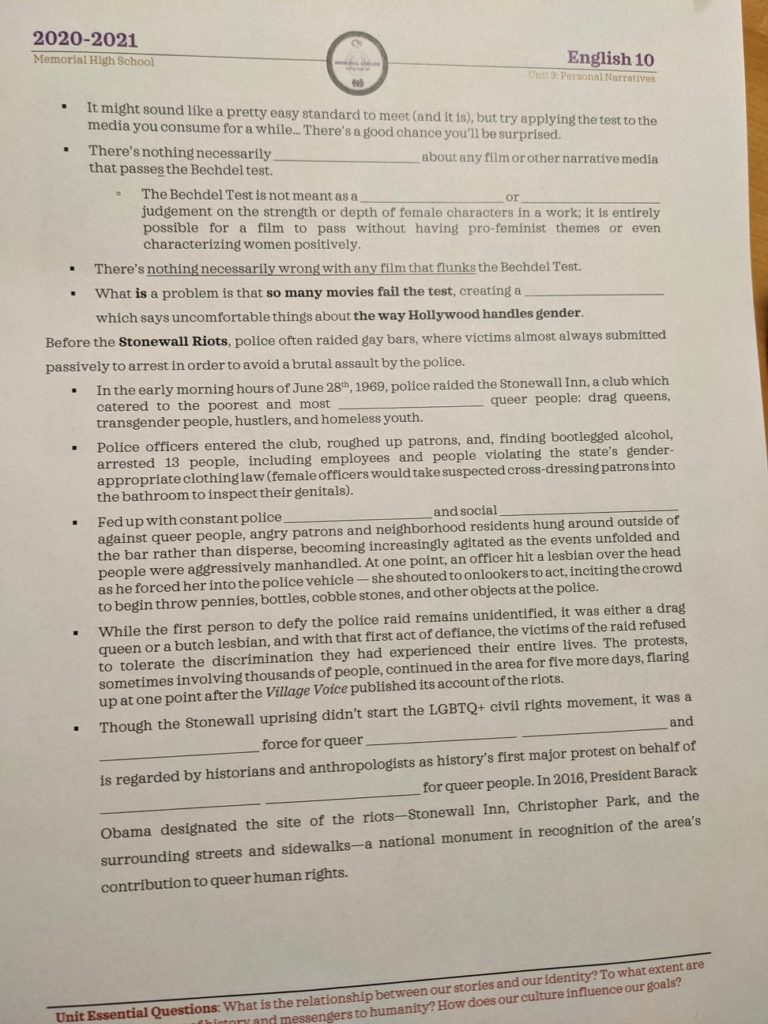

Stay Informed
